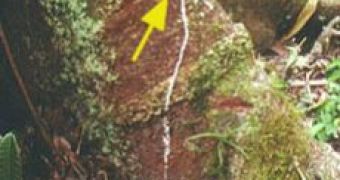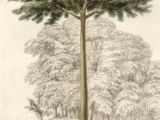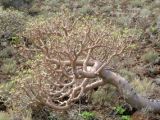We associate the term "milk" to an animal product.
Even if today we can eat soy milk, the liquid barely resembles by color and taste the real animal milk.
But in the vegetable kingdom, many plants, trees or the grass produce a white juice or sap, scientifically called latex or milk. That's why, surprisingly or not, vegetable milk does exist!
In the Andes of northwestern Venezuela grows palo de vaca or cow tree, tree milk (Brosimum galactodendron=Galactodendron utile), yielding a milky juice which is used as a wholesome and nourishing food.
The tree is related to figs (Ficus) and mulberry trees, which also yield a caustic milky sap.
This is what depicted the German explorer Alexander von Humboldt two centuries ago: "On the barren flank of a rock grows a tree with coriaceous and dry leaves. Its large, woody roots can scarcely penetrate into the stone. For several months of the year not a single shower moistens its foliage. Its branches appear dead and dried; but when the trunk is pierced there flows from it a sweet and nourishing milk. It is at the rising of the sun that this vegetable fountain is most abundant. The negroes and natives are then seen hastening from all quarters, furnished with large bowls to receive the milk which grows yellow and thickens at its surface. Some empty their bowls under the tree itself, others carry the juice home to their children."
"When incisions are made in the trunk of this tree, it yields abundance of a glutinous milk, tolerably thick, devoid of all acridity, and of an agreeable and balmy smell. It was offered to us in the shell of a calabash. We drank considerable quantities of it in the evening before we went to bed, and very early in the morning, without feeling the least injurious effect. The viscosity of this milk alone renders it a little disagreeable. The negroes and the free people who work in the plantations drink it, dipping into it their bread of maize or cassava. The overseer of the farm told us that the negroes grow sensibly fatter during the season when the palo de vaca furnishes them with most milk."
The latex consumption is accompanied by a sensation of astringency on the lips and palate, but it is sweet and pleasant. Today, this cow-tree is grown also in Ceylon and India, and plantation workers use to soak cornbreads in this milk. Moreover, the sap and leaves of Brosimum are galactogenic: they increase breast milk supply.
And from this milk a "cheese" is also made, as described by Humboldt. "This juice, exposed to the air, presents at its surface membranes of a strongly animalized substance, yellowish, stringy, and resembling cheese. These membranes, separated from the rest of the more aqueous liquid, are elastic, almost like caoutchouc; but they undergo, in time, the same phenomena of putrefaction as gelatine. The people call the coagulum that separates by the contact of the air, cheese. This coagulum grows sour in the space of five or six days. The milk contained in a stopped phial, had deposited a little coagulum; and, far from becoming fetid, it exhaled constantly a balsamic odour. The fresh juice mixed with cold water was scarcely coagulated at all; but on the contact of nitric acid the separation of the viscous membranes took place."
Farmers feeding leaves and branches to their cows and goats note an increase in milk production of 1 to 2 liters per day. Pharmaceutical companies are now finding that Brosimum sap helps cure stomach and digestive ailments, something the Maya people (who cultivate other Brosimum species for their nuts) have known for centuries.
Another milk tree is found also in South America, in Guyana. Demerara milk tree or hya-hya (Lacmellea utilis=Tabernaemontana utilis), 9-12 m tall, produces a nutritious, probably febrifuge latex which can be drunk like the milk, without being related to the previous species. This milk was consumed since ever by the Arawak Indians.
From an incision in the bark a good flow is obtained of thick, white, creamy, nutritious sap of a rich, nutty flavor that forms a good substitute for the cow's milk.
Another milk tree is masaranduba (Manilkara hexandra = Mimusops hexandra), no taller than 12 m. The 1-1.5 cm wide berries have a taste resembling strawberries with sour cream.
The latex of the stem is tasty, inodorous, exceedingly rich, resembling more that of new milk than of anything. Another milk tree is sweet tabaiba (Euphorbia balsamifera) from Canary Islands and north Africa.
This 3 m (10 feet) tall shrub is from the spurge genus and like all spurges it secrets a milky latex, but, unlike other spurges, the milk is not toxic, being sweet and harmless. Despite the name of the shrub, in fact its milk has no alimentary uses but medicinal ones. The tabaiba latex was chewed for strengthening the teeth and as antalgic treatment of acute dental pulpitis. This milk is also used against calluses, warts or moles, being very effective.
There is also a Ceylon cow-tree (Gymnema lactiferum = Asclepias lactifera). This milk is bland, even if related species have toxic latex. The latex of this tree resembles the color and consistency of the milk, but is not a milk substitute. It's used medicinally by the natives, but never as food. The leaves, when chopped and boiled, are administered to nurses by native practitioners, and are supposed to increase the secretions of milk.

 14 DAY TRIAL //
14 DAY TRIAL // 


